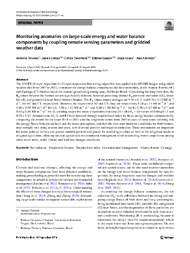Monitoring anomalies on large?scale energy and water balance components by coupling remote sensing parameters and gridded weather data.
Monitoring anomalies on large?scale energy and water balance components by coupling remote sensing parameters and gridded weather data.
Author(s): TEIXEIRA, A. H. DE C.; LEIVAS, J. F.; TAKEMURA, C. M.; GARCON, E. A. M.; SOUSA, I. F. DE; AZEVEDO, A.
Summary: Abstract The SAFER (Simple Algorithm for Evapotranspiration Retrieving) algorithm was applied with MODIS images and gridded weather data from 2007 to 2021, to monitor the energy balance components and their anomalies, in the Atlantic Forest (AF) and Caatinga (CT) biomes inside the coastal agricultural growing zone, Northeast Brazil. Considering the long-term data, the Rn values between the biomes are not significantly different, however presenting distinct Rn partitions into latent (?E), sensible (H), and ground (G) heat fluxes between biomes. The Rn values annual averages are 9.40 ± 0.21 and 9.50 ± 0.23 MJ m? 2 d? 1, for AF and CT, respectively. However, for respectively AF and CT, they are respectively 5.10 ± 1.14 MJ m? 2 d? 1 and 4.00 ± 0.99 MJ m? 2 d? 1 for ?E; 3.80 ± 1.12 MJ m? 2 d? 1 and 5.00 ± 1.00 MJ m? 2 d? 1 for H; 0.50 ± 0.12 MJ m? 2 d? 1 and 0.40 ± 0.10 MJ m? 2 d? 1 for G, yielding respective mean evaporative fraction (Ef = ?E/(Rn – G) values of 0.60 ± 0.12 and 0.50 ± 0.15. Anomalies on ?E, H, and Ef were detected through standardized index for these energy balance components by comparing the results for the years 2018 to 2021 with the long-term values from 2007 to each of these years, showing that the energy fluxes between surfaces and the lower atmosphere, and then the root-zone moisture conditions for both biomes, may strongly vary along seasons and years, with alternate positive and negative anomalies. These assessments are important for water policies as they can picture suitable periods and places for rainfed agriculture as well as the irrigation needs in irrigated agriculture, allowing rational agricultural environmental management while minimizing water competitions among other water users, under climate and land-use changes conditions.
Publication year: 2024
Types of publication: Journal article
Unit: Embrapa Territorial
Observation
Some of Embrapa's publications are published as ePub files. To read them, use or download one of the following free software options to your computer or mobile device. Android: Google Play Books; IOS: iBooks; Windows and Linux: Calibre.
Access other publications
Access the Agricultural Research Database (BDPA) to consult Embrapa's full library collection and records.
Visit Embrapa Bookstore to purchase books and other publications sold by Embrapa.

